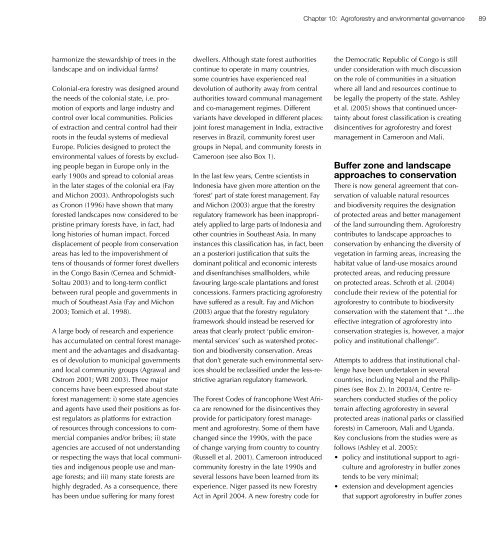The challenge of HIV/AIDS: Where does agroforestry fit in? - World ...
The challenge of HIV/AIDS: Where does agroforestry fit in? - World ...
The challenge of HIV/AIDS: Where does agroforestry fit in? - World ...
Create successful ePaper yourself
Turn your PDF publications into a flip-book with our unique Google optimized e-Paper software.
Chapter 10: Agr<strong>of</strong>orestry and environmental governance89harmonize the stewardship <strong>of</strong> trees <strong>in</strong> thelandscape and on <strong>in</strong>dividual farms?Colonial-era forestry was designed aroundthe needs <strong>of</strong> the colonial state, i.e. promotion<strong>of</strong> exports and large <strong>in</strong>dustry andcontrol over local communities. Policies<strong>of</strong> extraction and central control had theirroots <strong>in</strong> the feudal systems <strong>of</strong> medievalEurope. Policies designed to protect theenvironmental values <strong>of</strong> forests by exclud<strong>in</strong>gpeople began <strong>in</strong> Europe only <strong>in</strong> theearly 1900s and spread to colonial areas<strong>in</strong> the later stages <strong>of</strong> the colonial era (Fayand Michon 2003). Anthropologists suchas Cronon (1996) have shown that manyforested landscapes now considered to beprist<strong>in</strong>e primary forests have, <strong>in</strong> fact, hadlong histories <strong>of</strong> human impact. Forceddisplacement <strong>of</strong> people from conservationareas has led to the impoverishment <strong>of</strong>tens <strong>of</strong> thousands <strong>of</strong> former forest dwellers<strong>in</strong> the Congo Bas<strong>in</strong> (Cernea and Schmidt-Soltau 2003) and to long-term conflictbetween rural people and governments <strong>in</strong>much <strong>of</strong> Southeast Asia (Fay and Michon2003; Tomich et al. 1998).A large body <strong>of</strong> research and experiencehas accumulated on central forest managementand the advantages and disadvantages<strong>of</strong> devolution to municipal governmentsand local community groups (Agrawal andOstrom 2001; WRI 2003). Three majorconcerns have been expressed about stateforest management: i) some state agenciesand agents have used their positions as forestregulators as platforms for extraction<strong>of</strong> resources through concessions to commercialcompanies and/or bribes; ii) stateagencies are accused <strong>of</strong> not understand<strong>in</strong>gor respect<strong>in</strong>g the ways that local communitiesand <strong>in</strong>digenous people use and manageforests; and iii) many state forests arehighly degraded. As a consequence, therehas been undue suffer<strong>in</strong>g for many forestdwellers. Although state forest authoritiescont<strong>in</strong>ue to operate <strong>in</strong> many countries,some countries have experienced realdevolution <strong>of</strong> authority away from centralauthorities toward communal managementand co-management regimes. Differentvariants have developed <strong>in</strong> different places:jo<strong>in</strong>t forest management <strong>in</strong> India, extractivereserves <strong>in</strong> Brazil, community forest usergroups <strong>in</strong> Nepal, and community forests <strong>in</strong>Cameroon (see also Box 1).In the last few years, Centre scientists <strong>in</strong>Indonesia have given more attention on the‘forest’ part <strong>of</strong> state forest management. Fayand Michon (2003) argue that the forestryregulatory framework has been <strong>in</strong>appropriatelyapplied to large parts <strong>of</strong> Indonesia andother countries <strong>in</strong> Southeast Asia. In many<strong>in</strong>stances this classification has, <strong>in</strong> fact, beenan a posteriori justification that suits thedom<strong>in</strong>ant political and economic <strong>in</strong>terestsand disenfranchises smallholders, whilefavour<strong>in</strong>g large-scale plantations and forestconcessions. Farmers practic<strong>in</strong>g agr<strong>of</strong>orestryhave suffered as a result. Fay and Michon(2003) argue that the forestry regulatoryframework should <strong>in</strong>stead be reserved forareas that clearly protect ‘public environmentalservices’ such as watershed protectionand biodiversity conservation. Areasthat don’t generate such environmental servicesshould be reclassified under the less-restrictiveagrarian regulatory framework.<strong>The</strong> Forest Codes <strong>of</strong> francophone West Africaare renowned for the dis<strong>in</strong>centives theyprovide for participatory forest managementand agr<strong>of</strong>orestry. Some <strong>of</strong> them havechanged s<strong>in</strong>ce the 1990s, with the pace<strong>of</strong> change vary<strong>in</strong>g from country to country(Russell et al. 2001). Cameroon <strong>in</strong>troducedcommunity forestry <strong>in</strong> the late 1990s andseveral lessons have been learned from itsexperience. Niger passed its new ForestryAct <strong>in</strong> April 2004. A new forestry code forthe Democratic Republic <strong>of</strong> Congo is stillunder consideration with much discussionon the role <strong>of</strong> communities <strong>in</strong> a situationwhere all land and resources cont<strong>in</strong>ue tobe legally the property <strong>of</strong> the state. Ashleyet al. (2005) shows that cont<strong>in</strong>ued uncerta<strong>in</strong>tyabout forest classification is creat<strong>in</strong>gdis<strong>in</strong>centives for agr<strong>of</strong>orestry and forestmanagement <strong>in</strong> Cameroon and Mali.Buffer zone and landscapeapproaches to conservation<strong>The</strong>re is now general agreement that conservation<strong>of</strong> valuable natural resourcesand biodiversity requires the designation<strong>of</strong> protected areas and better management<strong>of</strong> the land surround<strong>in</strong>g them. Agr<strong>of</strong>orestrycontributes to landscape approaches toconservation by enhanc<strong>in</strong>g the diversity <strong>of</strong>vegetation <strong>in</strong> farm<strong>in</strong>g areas, <strong>in</strong>creas<strong>in</strong>g thehabitat value <strong>of</strong> land-use mosaics aroundprotected areas, and reduc<strong>in</strong>g pressureon protected areas. Schroth et al. (2004)conclude their review <strong>of</strong> the potential foragr<strong>of</strong>orestry to contribute to biodiversityconservation with the statement that “…theeffective <strong>in</strong>tegration <strong>of</strong> agr<strong>of</strong>orestry <strong>in</strong>toconservation strategies is, however, a majorpolicy and <strong>in</strong>stitutional <strong>challenge</strong>”.Attempts to address that <strong>in</strong>stitutional <strong>challenge</strong>have been undertaken <strong>in</strong> severalcountries, <strong>in</strong>clud<strong>in</strong>g Nepal and the Philipp<strong>in</strong>es(see Box 2). In 2003/4, Centre researchersconducted studies <strong>of</strong> the policyterra<strong>in</strong> affect<strong>in</strong>g agr<strong>of</strong>orestry <strong>in</strong> severalprotected areas (national parks or classifiedforests) <strong>in</strong> Cameroon, Mali and Uganda.Key conclusions from the studies were asfollows (Ashley et al. 2005):• policy and <strong>in</strong>stitutional support to agricultureand agr<strong>of</strong>orestry <strong>in</strong> buffer zonestends to be very m<strong>in</strong>imal;• extension and development agenciesthat support agr<strong>of</strong>orestry <strong>in</strong> buffer zones




![MNC_00_Modau [Compatibility Mode].pdf](https://img.yumpu.com/51432208/1/190x146/mnc-00-modau-compatibility-modepdf.jpg?quality=85)











